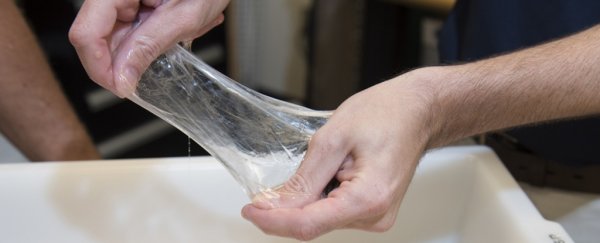US Navy scientists have turned to the natural world for their latest line of defence, developing their own synthetic version of the incredibly tough, expandable slime that's expelled by hagfish at would-be predators.
Hagfish are bottom-dwelling fish that deploy their slime to obstruct the gills of any underwater predators trying to eat them, and engineers are hoping to use a new artificial version of the thick slime to protect divers, block ballistics, fight fires, and even keep away sharks.
Not only is hagfish slime super tough, it can expand up to 10,000 times in size upon contact with water, and it's those properties that scientists from the Naval Surface Warfare Centre are keen to harness.
"Researchers have called the hagfish slime one of the most unique biomaterials known," says one of the team, materials engineer Ryan Kincer. "For the US Navy to have its hands on it or a material that acts similar would be beneficial."
There are two protein-based components in hagfish slime: tightly coiled threads, and a sticky membrane covering called mucin.
When the slime is excreted, the threads quickly uncoil and the mucin binds to water, releasing the connecting proteins between threads, and allowing the slime to quickly expand into a gluey, elastic shield.
It's not unlike Spider-Man's signature move, only with slime instead of silk. In fact, hagfish slime is often compared with spider silk because of its natural strength - the slime is up to five times stronger than steel for its weight.
To get their own supply of hagfish slime in the lab, scientists tweaked E. coli bacteria to produce the required proteins, before combining them together in a specially engineered solution. A scanning electron microscope was used to confirm that what they'd created matched the real deal.
Now the team is looking to increase the slime's surface area and stability, as well as working on potential delivery methods - a slime-shooting ship gun, anyone?
"Our goal is to produce a substance that can act as non-lethal and non-kinetic defence to protect the warfighter," says team member Josh Kogot.
And this being the Navy, the way the slime reacts and expands in water is an important factor in figuring out how it could be used.
"From a tactical standpoint, it would be interesting to have a material that can change the properties of the water at dilute concentrations in a matter of seconds," adds Kogot.
Scientists have long been interested in the special properties of hagfish slime, which offers that rare combination of low weight and high strength, but it's only recently that we've been able to understand how it's made.
There's been no peer-reviewed results published as yet on just how effective the Navy's version of the hagfish slime is, so until we see something published, we need to take their word for it. But we're keen to see what they do with it next.
"The synthetic hagfish slime may be used for ballistics protection, firefighting, anti-fouling, diver protection, or anti-shark spray," says Kogot. "The possibilities are endless."
